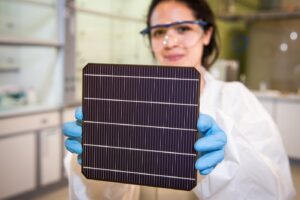In the search for clean energy to power a post-combustion world, one is constantly reminded of the massive energy source overhead. Incoming solar radiation hitting the Earth’s upper atmosphere is estimated at 174 petawatts (1 petawatt = one quadrillion or 1015 watts). With that much energy overhead one would think it could be more easily harnessed, yet photovoltaic solar cells suffer from high costs and low efficiency compared to other energy sources. With more resources focused on research in clean energy, there are high expectations associated with the development of inexpensive solar modules based on photovoltaic technologies. Perovskite solar cells are an early-stage contender in the race for a better solar cell and one that may provide potential opportunity for the mining industry.
Photovoltaic technologies
Photovoltaic technologies are designed to generate electricity by converting solar energy into the flow of electrons. Generally, photovoltaic technologies include first, second and third generation cells according to their development stages. The first generation solar cells are built on silicon crystal, a dominant semiconductor for the photovoltaic technology. The second generation are made of CdTe (cadmium telluride), CIGS (copper, indium, gallium and selenide) and amorphous silicon, whose films thickness ranges from a few nanometers to tens of microns. Other thin film technologies containing CZTS (copper tin zinc sulphide), nanocrystals, polymers, and perovskites are the third generation of solar devices.
Today, the mainstream silicon-based solar technology has reached the limits of its practical and cost-effective photovoltaic efficiency. To achieve a significant decrease in the cost of renewable solar energy, research is ongoing on the development of third generation solar cells, especially perovskite solar cells and its hybrid varieties, where a major breakthrough has occurred in recent years.
What is perovskite?
Perovskite is a calcium titanium oxide mineral with the chemical formula CaTiO3. Its name is also applied to the class of compounds which have the same type of crystal structure. Perovskite materials exhibit many interesting and intriguing properties including high light absorptivity, greater charge-carrier mobility, longer exciton diffusion length, easily tunable bandgap and low exciton binding energy, thus making it a good candidate for solar cells. Many different ions can be embedded in the perovskite structure, allowing the development of diverse engineered materials. Based on the typical chemical formula ABX3, there are A, B cations and X anion possessing different charges and dimensions.

Cation A engaging with a small monovalent cation of rubidium (Rb), cesium (Cs), methylammonium (MA), formamidine (FA) was found to have no direct effect on the electronic properties of perovskite. However, the size of cation A can change the degree of distortion of the structure, which ultimately affects the electronic characteristics of the perovskite material.
Cation B hybrid perovskite materials are generally filled with metals of the carbon group in a +2 oxidation state (lead, tin, germanium). Lead was the most widely used metal and showed much better performance and stability than tin.
Varying the halide ion (i.e. fluorine, chlorine, bromine, iodine) in the Anion X position appears to be the most effective method for probing the performance characteristics of hybrid perovskite photovoltaics.
What are the benefits of perovskite solar cells?
While a century was required to get the efficiency of silica solar cells up to 26.7%, just a decade was enough to develop hybrid perovskite solar panels with similar efficiency. That is, the efficiency of perovskite solar cells increased from 3.8% in 2009 to 25.2% in 2020, and in silicon-based hybrid cells to 29.1%. Unlike thick and rigid silicon wafers, perovskite films are thin (approximately 300 nm to 1 μm) and flexible.
Perovskite solar cells also have an advantage over conventional silicon solar cells in part due to their relatively easy, low cost fabrication. Conventional silicon cells require expensive multistage processes performed at high temperatures (> 1000 °C), whereas organic-inorganic perovskite is made by simple wet chemistry methods at room temperature or slightly higher.
Research in perovskite solar cells aim at improving efficiency and reducing the cost of the cells. The great advantage of perovskite photovoltaic over conventional solar technologies is that they can respond to different wavelengths of light, allowing them to convert more sunlight into electricity.
What are the disadvantages of perovskite solar cells?
Despite its great potential, perovskite solar technology is still in the early stages of commercialization compared to other mature solar technologies and there are a number of concerns remaining. For example, perovskite solar panels are unstable, exhibiting rapid degradation in light, heat (~100 °C), and air exposure. Moreover, the presence of lead atoms in hybrid perovskites is quite unfavorable for large area applications where leaching may occur.
The present and the future of perovskite solar industry
Despite the existing problems, perovskite-based solar cells are considered the future of the solar industry. Scientists and companies are working to improve efficiency and stability, extend service terms, and replace toxic materials with safer ones.
In 2015, Saule Technologies signed an investment agreement with Japanese investment company Hideo Sawada. Saule aims to combine flexible perovskite solar panels with other currently available products. Saule Technologies also introduced the first real-life applications of perovskite solar cells – a mobile phone charger that operates under artificial light and inkjet-print an A4, flexible, perovskite solar module on an ultrathin plastic foil. Commercialization of the technology and a prototype production line of the first industrial-size modules (100 x 100 cm) is planned for 2020.

British startup Oxford Photovoltaics (PV) is also active in developing perovskite solar cells. In June 2018, Oxford PV produced 1 cm² perovskite-silicon tandem solar cell, reaching a 27.3% conversion efficiency, certified by the Fraunhofer Institute for Solar Energy Systems ISE. This exceeds the 26.7% efficiency world record for a single-junction silicon solar cell.
Perovskite solar cells still face several challenges, but there is ongoing research and progress on a number of fronts. With the potential to achieve even greater efficiency and very low production costs, perovskite solar panels have become commercially attractive.
Perovskite solar cells and the mining industry
While the photovoltaic phenomenon was initially studied using natural perovskites, the minerals are fairly easy to synthesize and mining for these minerals is not likely to be practical. However, the production high efficiency perovskite cells at an industrial-scale may require a specific sets of elements including lead, tin, germanium, rubidium and cesium. Since research is ongoing it’s hard to say where the needle will stop, but as we’ve discussed before, modern technologies increasingly require Rare Earth Elements, uncommon and rare metals.
Futher Reading
- NREL Best Research-Cell Efficiency Chart (Website)
- NREL Photovoltaic Research (Website)
- Global Market Outlook For Solar Power / 2018-2022 (PDF)
- Oxford PV (Website)
- Frontiers, opportunities, and challenges in perovskite solar cells: A critical review (Academic Article)
Subscribe for Email Updates









